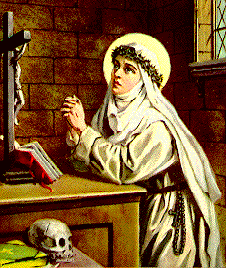
Memorial - April 29
Born in Siena, Italy, March 25, 1347
Died in Florence, Italy, April 29, 1380
Declared A Doctor Of The Church in 1970
Patronage: Against fire, firefighters, bodily ills, miscarriages, people ridiculed for their piety, sexual temptations, temptations, Italy, Europe, Siena.
![]()
From Her Writings:
Charity is the sweet and holy bond which links the soul with its Creator:
it binds God with man and man with God.
-Saint Catherine of Siena
Eternal Trinity, Godhead, mystery deep as the sea, you could give me no
greater gift than the gift of yourself. For you are a fire ever burning
and never consumed, which itself consumes all the selfish love that fills
my being. Yes, you are a fire that takes away the coldness, illuminates
the mind with its light, and causes me to know your truth. And I know that
you are beauty and wisdom itself. The food of angels, you gave yourself
to man in the fire of your love.
-from On Divine Providence by Saint Catherine of Siena
Everything comes from love, all is ordained for the salvation of man, God
does nothing without this goal in mind.
-Saint Catherine of Siena
Those in union with God when aware of the sins of others live in this gentle
light. . . . Therefore they are always peaceful and calm, and nothing can
scandalize them because they have done away with what causes them to take
scandal, their self-will. . . . They find joy in everything.
"They do not sit in judgement on my servants or anyone else, but rejoice
in every situation and every way of living they see. . . . Even when they
see something that is clearly sinful, they do not pass judgement, but rather
feel a holy and genuine compassion, praying for the sinner.
-Saint Catherine of Siena
Whenever you think God has shown you other people's faults, take care:
your own judgment may well be at fault. Say nothing. And if you do attribute
any vice to another person, immediately and humbly look for it in yourself
also. Should the other person really possess that vice, he will correct
himself so much the better when he sees how gently you understand him, and
he will say to himself whatever you would have told him.
-Saint Catherine of Siena
![]()
Prayer of Saint Catherine of Siena to the Precious Blood of Jesus
Precious Blood,
Ocean of Divine Mercy:
Flow upon us!
Precious Blood,
Most pure Offering:
Procure us every Grace!
Precious Blood,
Hope and Refuge of sinners:
Atone for us!
Precious Blood,
Delight of holy souls:
Draw us! Amen.
-Saint Catherine Of Siena
Prayer for the Gifts of Saint Catherine of Siena
God of Wisdom you made our sister Catherine burn with divine love in contemplating
the Lord's passion and in serving your Church. With the help of her prayers
may your people, united in the mystery of Christ, rejoice forever in the
revelation of his glory, who lives and reigns with you and the Holy Spirit,
God, for ever and ever. Amen.
Novena Prayer to Saint Catherine of Siena
O marvelous wonder of the Church, seraphic virgin, Saint Catherine, because
of your extraordinary virtue and the immense good which you accomplished
for the Church and society, you are acclaimed and blessed by all people.
Oh, turn your benign countenance to me who, confident of your powerful patronage,
calls upon you with all the ardor of affection and begs you to obtain,
by your prayer, the favors I so ardently desire.
You, who were a victim of charity, who in order to benefits your neighbor
obtained from God the most stupendous miracles and became the joy and the
hope of all, you cannot help but hear the prayers of those who fly into
your heart - that heart which you received from the Divine Redeemer in a
celestial ecstasy.
Yes, O seraphic virgin, demonstrate once again proof of you power and of
your flaming charity, so that your name will be ever more blessed and exalted;
grant that we, having experienced your most efficacious intercession here
on earth, may come one day to thank you in heaven and enjoy eternal happiness
with you. Amen.
Prayer to Saint Catherine of Sienna
Humble virgin and Doctor of the Church, in thirty-three years you achieved
great perfection and became the counselor of Popes. You know the temptations
of mothers today as well as the dangers that await unborn infants. Intercede
for me that I may avoid miscarriage and bring forth a healthy baby who will
become a true child of God. Also pray for all mothers, that they may not
resort to abortion but help bring a new life into the world. Amen.
Prayer to Saint Catherine of Siena
Tertiary and Doctor of the Church, you were full of wisdom, the special
gift of God, and you knew how to guide even Pontiffs, as well as how to
extinguish fiery passions and restore true peace among people. How inspiring
your spiritual writings and how heroic your abstemious life! Fires are today
unfortunately all too common - including those caused by criminals. Please
protect and encourage firefighters in their heroic efforts to save lives.
Amen.
![]()
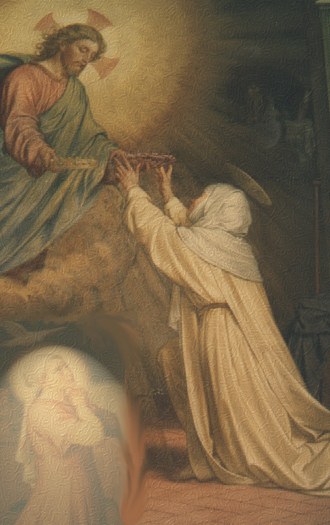
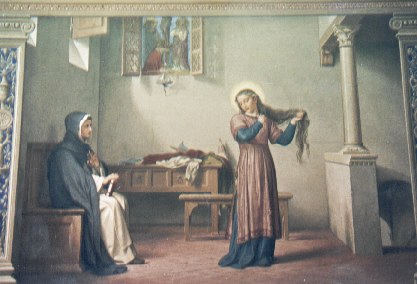


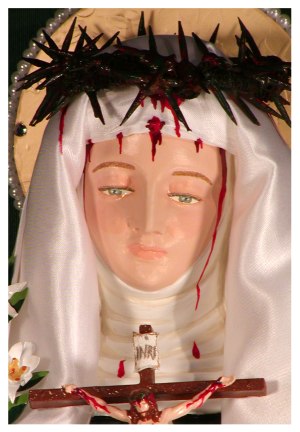
Saint Catherine of Siena: How To Receive The Eucharist More Worthily
Holy Communion is a daily renewal of our covenant of love with the Lord.
As we receive Communion each day, we receive the graces needed to deepen
the commitment of our vocation.
How can we best experience all these wonderful effects of receiving Holy
Communion in our lives?
St Catherine of Siena, a 14th-century mystic and Doctor of the Church, devotes several chapters in her book, The Dialogue, to the mystery of the Eucharist. Catherine, who lived for many years solely on the Eucharist, encourages us to receive Holy Communion as frequently as possible, and guides us in ways of making it fruitful for our spiritual lives. She explains four qualities, or attitudes of heart, that help deepen our reception of the Eucharist: faith, love, desire and conversion. Faith, one of the great gifts of baptism and the foundation of the spiritual life, is the most essential and necessary disposition for a fruitful Communion. A living faith believes in the Trinity's personal love for each of us. St Augustine's faith led him to say, "God cares for each of us as if he alone existed, and for all of us as if we were but one." Jesus loves us to the point of death and beyond, for he continues to give himself to us under the appearance of bread and wine. Catherine urges us to a faith that believes Jesus is totally and truly present in the Blessed Sacrament. This Jesus wants to be intimately united with us so we can share in his divine life. We must believe. "And if we do not, for our faith is weak and tiny, what then?" asks Catherine. We should pray that each Holy Communion will increase our mustard-seed faith.
Faith leads to love, the second quality. We were created to love and to
be loved. When we see how much we are loved by God, the only adequate response
is to love in return. A lover wants to be with the beloved; Jesus wants
to be with us, to be within us.
The best way we can express a free, self-giving love for God is through
love of neighbour. The Eucharist is the self-giving love of the Saviour.
Fruitful reception of Holy Communion deepens our love for God and neighbour.
The third disposition we need is desire. Catherine said our human actions
are finite, but our desires can be infinite. We can, and should, desire
God Himself, because He desires us.
If we do not expect much from Holy Communion, we won't receive much. Everyone
receives the same amount, but some grow spiritually, while others do not.
Catherine explains that this is due to each one's desire for God. We can
desire, and receive as we are able, the fullness of God!
The deepest desires of our hearts are from the Holy Spirit. Catherine would
have us stir up desires for virtue, the gifts of the Spirit, holiness, union
with God.
Desire determines the spiritual fruitfulness of Holy Communion. Desire for
God will direct all our actions toward giving Him honour and glory, not
only at Mass, but also during each moment of the day.
The first three attitudes need the fourth: ongoing conversion from sin and
its tendencies. As we advance in faith, love and desire, the Spirit reveals
more clearly our shortcomings. We see how much more we need to change. Conversion
is a process of growth, moving forward, step by step. We turn away from
our old ways of living and begin thinking and acting like the Person we have
received in Holy Communion.
Catherine usually expressed herself in simple images so everyone would understand
her. She used the image of a candle in describing the dispositions necessary
to receive Holy Communion. Its gentle, warm glow is an image rich with meaning
for Catholics, because every tabernacle in the world is indicated by a burning
candle.
Catherine points out that the wick must penetrate the core of the entire
candle or it will not burn correctly or completely. It will stop where the
wick stops, or become deformed if the wick is not straight. So, too, our
faith must be straight, steady, consistent, permeating our entire lives.
The wick of faith penetrates the candle so it can burn with the fire of
love.
Sins are like water thrown on the flame. Instead of a rich warm glow, there
is a hiss, smoke and death. The flame needs to be dried by the fire of true
contrition and confession of sin. Conversion returns the warmth of faith,
love and desire.<.b>
Catherine offers us a further way to remember the qualities needed for a
fruitful Holy Communion. Conversion purifies us so we can see the Blessed
Sacrament with the eyes of faith, receive it with the hands of love and
taste it with the spiritual sense of holy desire.
People who love the Eucharist and attend Mass frequently realise that only
the Holy Spirit can stir up our desire for Jesus. For those of us who do
not experience this spiritual hunger, it is never too late to turn to the
Spirit in prayer.
This article, here shortened, first appeared in 'Our Sunday Visitor,' a
US Catholic weekly. Sr Mary Jeremiah is a member of the Dominican community
at the Monastery of the Infant Jesus in Lufkin, Texas.
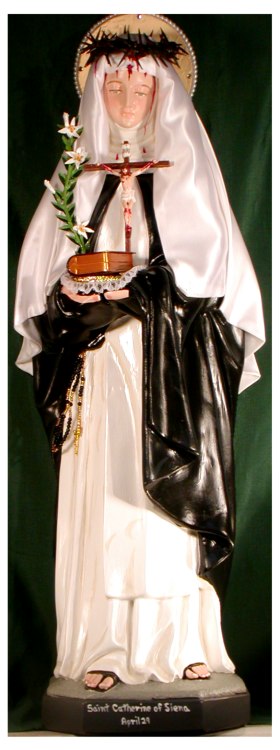
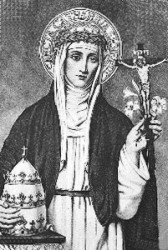
Fourteenth century Italy was desolated by plague, schism, and political turmoil.
When we are tempted to think that we live in the worst of times, we should
remember the life of Saint Catherine. Those days were so black that many
saints and scholars believed it heralded the end of the world. The popes
deserted Rome for Avignon in 1305. Rome itself was in anarchy. Yet in the
midst of confusion and dissent within the Church, God raised up Catherine,
one of many saints who prove that our hope in the Lord is never in vain.
Siena had established itself as a military power by conquering Florence
in 1260. The city, which possessed a university with a school of medicine
and superb cathedral, was governed by the Governo dei Nove (Government of
Nine). Art was closely bound to life in Siena. Sienese artists were the
most faithful interpreters of the sentiments and ideas of its great mystics.
Legend says that Siena was founded by Romulus and Remus or by Remus's sons
Ascius and Senius, who created its black and white flag.
Giacomo di Benincasa had a thriving cloth dying business on the Vicolo del
Tiratoio (Street of the Dyers) with three of his sons: Bartolommeo, Orlando,
and Stefano, plus two journeymen and two apprentices. The family lived upstairs.
The also had a family farm.
When Benincasa's domineering and shrewish wife Lapa, daughter of a now forgotten
poet, gave birth to twin daughters, Catherine and Giovanna, she already
had 22 children. Lapa kept Catherine and breastfed her, but didn't have
enough milk for her twin, who was given to another's care and eventually
died. A 25th child was born and named Giovanna also, though she lived only
a few years. Thirteen of the children lived to adulthood and all remained
at home until they were married. Eventually eleven grandchildren were included
in the household, which was big enough to include a foster son Tommaso della
Fonte, whose parents died in the plague of 1348.
Though Catherine was not a pretty child, she was popular in the neighborhood
because of her gaiety and wise little sayings. According to her first biographer
she always had the ability to charm others. She was slight and pale, her
features delicate, the texture of her skin exquisite, and her hair long,
thick, lustrous, and golden. She was animated, cheerful, friendly, sensitive,
and charming. All her movements were swift and graceful.
Prayer came naturally to her. At the age of five she would kneel on each
step of the stairs of her home and say a prayer. She was only seven when
she reported her first vision--of Jesus seated on a throne surrounded by
saints, when returning with a younger brother from visiting one of her married
sisters. The young child dragged at her hand, but she was lost in ecstasy.
From that day she was consecrated to His service and engaged herself entirely
in prayer, meditation, and acts of penance in which she encouraged her friends
to join her.
Raymond of Capua, her confessor and biographer, wrote "... taught entirely
by the Holy Spirit, she had come to know and value the lives and way of
life of the holy Fathers of Egypt and the great deeds of other saints, especially
, and had felt such a strong desire to do what they did that she had been
unable to think about anything else."
The Benincasas owned a small farm out the outskirts of San Rocca a Pilli,
14 km from Siena, where Catherine spent time. She had a passion for flowers
and wove them into little crosses for her early confessor Padre Tommaso.
She often dreamed that angels descended from Heaven and crowned her with
white lilies.
Her parents wanted her to marry and encouraged her to enhance her looks.
For a time she submitted to the ministrations of a hair dresser and to be
decked out in fashionable clothes, but she soon repented of her concession
meant to please her mother and sister Bonaventura. At age 16, when a real
courtship was imminent, however, she told her mother she had taken a vow
of perpetual virginity when she was seven. When her mother didn't take her
seriously, she cut off her luxurious golden hair ( as St. Rose of Lima did the same in a similar
situation).
Her mother was enraged, discharged their maid, and decided Catherine should
dress like a servant and perform a servant's tasks. Catherine accepted her
tasks cheerfully and performed them capably. The men of the family objected
but were overruled by Lapa; however, her father promised her that she would
not be forced into marriage and he insisted that she be given a room to
herself and time to pray because he had seen a white dove hovering above
her head.
She dreamed that she encountered Saint Dominic and was overcome with a desire
to enter the Third Order of the Dominican Sisters of Penance. At that time
there were about 100 devout older women and spinsters in Siena who were
known as Mantellates, because of the black capes they wore over their white
habits.
Still unpersuaded that her daughter would not marry, Lapa took her to the
spa at Vignone hoping to fatten her up in preparation for marriage. A week
later they returned. Catherine had scalded herself at the source of the
hot springs in order to disfigure herself. She had also contracted smallpox.
During her illness she extracted a promise from Lapa to ask the sisters
to accept her daughter. The Mother Superior said Catherine was too young
(pleasing Lapa) but Catherine insisted that the order had no rule about
it. Lapa assured her that Catherine had cut off her hair, scalded herself,
and now had smallpox, so that she would no longer be attractive. Then the
Mother agreed to visit Catherine. Several weeks later Catherine received
the mantle and habit.
For three years she left her bare room only to attend Mass, broke her silence
only for confession or to meet an emergency, ate sparingly and alone, and
recited the Divine Office during the hours when she knew that the Dominican
friars slept.
She underwent periods of aridity, but was never subject to temptation. On
Shrove Tuesday, 1367, she prayed for the "fullness of faith" and had a vision
in which she saw Jesus, Mary, , , and Saint Dominic, the founder of her
order. During this vision, the Blessed Virgin presented her to Jesus, who
espoused Himself to her. He placed on her finger a gold ring with four pearls
set in a circle in it and a wonderful diamond in the middle, saying to her,
"receive this ring as a pledge and testimony that you are mine and will
be mine for ever." No one else could see the ring but it was always before
her eyes.
She had many marvelous religious experiences. At the age of 26, she first
felt the pain of Christ's suffering in her own body. Two years later during
a visit to Pisa, she received Communion in the little church of Santa Christina.
As she meditated in thanksgiving upon the crucifix, five blood-red rays
seemed to come from it which pierced her hands, feet, and heart. Thus, she
received the five visible wounds of His suffering--the stigmata. It caused
such acute pain that she swooned. Unable or unwilling to eat, Catherine
went for eight years without food or liquid other than the Blessed Sacrament.
She prayed that the marks not be conspicuous, though they are traceable
on her incorruptible body by a transparency in the tissues.
Oftentimes she was seen levitated in the air during her prayer. Once, as
she was being given Holy Communion, the priest felt the Host become agitated
and fly, as if of its own volition, from his fingers into her mouth. In
the Life of Saint Catherine, Mother Francis Raphael relates that the saint
was immune to fire. She tells of a time that Catherine fell forward into
a fire in the kitchen during a religious ecstasy. The fire was large and
fierce, but when Catherine was pulled out of the smoking embers neither
she nor her clothes were damaged.
But none of these divine favors would have meant much to a needy world if
Catherine had remained hidden in her home. In 1370, she heard a divine voice
that commanded her to leave the cell and enter His service in the world
to promote the salvation of her neighbors. Thousands came to see her, to
hear her, and to be converted by her. A mystical circle of members of religious
orders, secular priests, and lay people gathered around her.
Of course, public opinion in Siena was sharply divided about Catherine.
It may have been in consequence of accusations made against her that she
was summoned to Florence to appear before the chapter general of the Dominicans.
If any charges were made, they were certainly disproved, and shortly thereafter
the new lector of Siena, Blessed Raymond, was appointed as her confessor.
The core of her teaching was: Man, whether in the cloister or in the world,
must live in a cell of self-knowledge, which is the stall in which the pilgrim
must be reborn from time to eternity. The press of the repentant was so
great that the three priests of her neighborhood, who had been provided
by the pope to hear the confessions of those who were induced by her to amend
their lives, could hardly cope with it.
She dispatched letters that often had been dictated in ecstasy, to men and
women of all ranks, entered into correspondence with kings and princes and
with the Italian city-states. She took part also in public affairs, and
Catherine welcomed all who came to call--the curious, the seeking, the devout.
She collected information from them all.
Even the pope relied upon her good judgment. At this time the papacy was
tragically weakened by contested papal elections, pope and antipope denouncing
each other. Catherine supported the true Pope Urban VI against his opponents;
but he was a somewhat graceless man, and her letters to him never hesitated
to reprove the pope for this fault, while remaining entirely loyal to him.
Twice at least she successfully intervened in matters of high politics.
Catherine made peace between cities torn by factional strife: she made peace
between the pope and the city of Florence. On June 18, 1376, Catherine arrived
in Avignon as unofficial ambassadress, and induced the pope to return to
Italy, and--this was the greatest work of her life--brought to an end the
Babylonian captivity of the popes. Thus, on September 13, 1376, Pope Gregory
XI started from Avignon to travel by water to Rome.
It was a month before Catherine arrived back in Siena, from where she continued
to exhort the pope to contribute to the peace of Italy. By his special request,
she went again to Florence, still rent by factions and obstinate in its
disobedience and under interdict. There she remained for some time amid
daily murders and confiscations, in danger of her life but never daunted,
even when swords were drawn against her. Finally, she established peace
between Florence and the Holy See.
Catherine dictated from memory The Dialogue in five days before she left
Siena forever. It is her account of her visions. She was clairaudient and
clairvoyant, also awareness of communion with Jesus. She was illiterate,
but yearning to be able to read the breviary, when suddenly she could read--either
through the help of Father Tommaso della Fonte or Alessia Saracini (her friend)
, or through a miracle.
Her foster brother Tommaso della Fonte became a priest and her confessor
during the time of her novitiate. He provided her with other books, such
as a short history of the Church, lives of the saints, the Psalms and other
portions of the Bible. She later astonished learned ecclesiastics with her
grasp of these subjects.
She loved music and to sing, was passionately fond of children. She began
to make friends again, first among the Mantellate and Dominicans, then among
the priests and physicians at the Hospital of Santa Maria della Scala, where
she began her nursing career, then among the intelligentsia. She had the
gift of healing. Much of what she did was met with ingratitude.
Catherine loved working amongst the sick. Unlike most other volunteers,
she would care for those with the most repulsive diseases, such as leprosy,
which was then virtually incurable. She gathered round her many friends,
and when a fearful plague broke out in Siena, she led them boldly among
those who had caught it-- sometimes even digging graves and burying the dead
herself.
Catherine also suffered moral temptations, and often it seemed that God
had deserted her. Was it for this that she had forsaken all to follow Him?
A woman suffering from cancer, to whom she had given devoted care, pursued
her with a vicious tongue and poured out upon her all the irritability and
despair which were provoked by her hopeless condition, but Catherine remained
incredibly patient and forbearing; her visions returned and her heart was
strengthened. "O my Savior, my Lord," she cried, "why did You forsake me?"
"My child," came the answer, "I have been with you through all. I was in
your heart all the while."
She gave freely from her father's resources to the poor beggars, some of
whom she claimed were saintly visitors in disguise. Through all her arduous
life she remained gentle and forgiving, serving Christ in the lives of the
poor, following Him into mean streets and crowded hovels, taking upon herself
the burden of pain and sin that she met with, nourished and sustained by
her frequent visions. Our Lord appeared to her holding in one hand a crown
of gold and in the other a crown of thorns, and asked which she would choose.
Without hesitation she reached out her hand for the crown of thorns.
Francesco di Vanni Malavolti, a famous philanderer, so desired Catherine's
friendship that he went immediately to confession. They had an spontaneous
and lasting friendship because of their mental harmony. After the death
of his wife, he entered the monastery and spent the remainder of his days
in prayer and contemplation.
Andrea Vanni was a friend whose portrait of her remains in the Church of
San Domenico in Siena. He and Catherine's brother Bartolo led the revolution
that toppled the government.
For thirty years this brave and devoted soul showed how there is a Power
that transcends our earthly life, and awakened many, by conversion, to a
sense of the Eternal. "Her prayers," we are told by an eyewitness, "were
of such intensity, that one hour of prayer more consumed that poor little
body than two days upon the rack would have done another."
When the great Western schism broke out following the death of Pope Gregory
in 1378, the new pope, Urban VI, called her to Rome. A rival pope was established
at Avignon by some cardinals who declared Urban's election was illegal.
Christendom was divided into two camps. She spoke to the cardinals in open
consistory, wrote to the chief sponsors of the schism, to foreign princes,
and through her influence, helped to overcome the French anti-pope in Italy.
She also continued to write to Urban, sometimes urging him to remain patient
in trials and other times admonishing him to abate his harshness that was
alienating even his supporters.
Instead of resenting her reproofs, Urban invited her to come to Rome to
advise and assist him. In obedience, she left Siena forever and took up
residence in the Eternal City. There she labored indefatigably by her prayers
and exhortations to gain new adherents to the true pontiff.
After she had offered her life as a sacrifice to God, and had seen and felt
in a vision the Almighty God pressing out her heart as a balm over the Church,
she fell mortally ill and died in the arms of Alessia Saracini after eight
weeks of most acute suffering at the age of 33--the age at which her Master
had died. And when she died, she was merry and joyful.
Catherine is one of the greatest mystics of all time. In her, the extraordinary
mystical states that are the preparation for true sanctifying graces and
the counterpart of the burdens of sainthood, became particularly evident.
The history of literature gives the saint a place of honor beside Dante
and Petrarch (Bentley, Gill, Harrison, Keyes, Schamoni, Walsh).
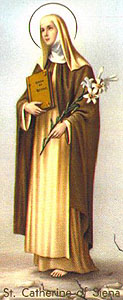
Some Favorite Links
Back To Pray For Priests
Dialog of Catherine Of Siena
In Honor Of Saint Andrew Kim - My Patron Saint
Diocese Of Beaumont